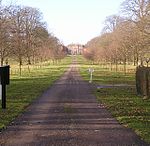Glewstone Court Hotel
Grade II listed buildings in HerefordshireHotels in Herefordshire

Glewstone Court, in the hamlet of Glewstone and the civil parish of Marstow in Herefordshire, England, is a building of historical significance listed on the English Heritage Register It was built in about 1810 for Charles Ballinger, a wealthy landowner from Chalford in Gloucestershire. It is now a country house hotel.
Excerpt from the Wikipedia article Glewstone Court Hotel (License: CC BY-SA 3.0, Authors, Images).Glewstone Court Hotel
Geographical coordinates (GPS) Address Nearby Places Show on map
Geographical coordinates (GPS)
| Latitude | Longitude |
|---|---|
| N 51.898611111111 ° | E -2.6366666666667 ° |
Address
HR9 6AW
England, United Kingdom
Open on Google Maps








